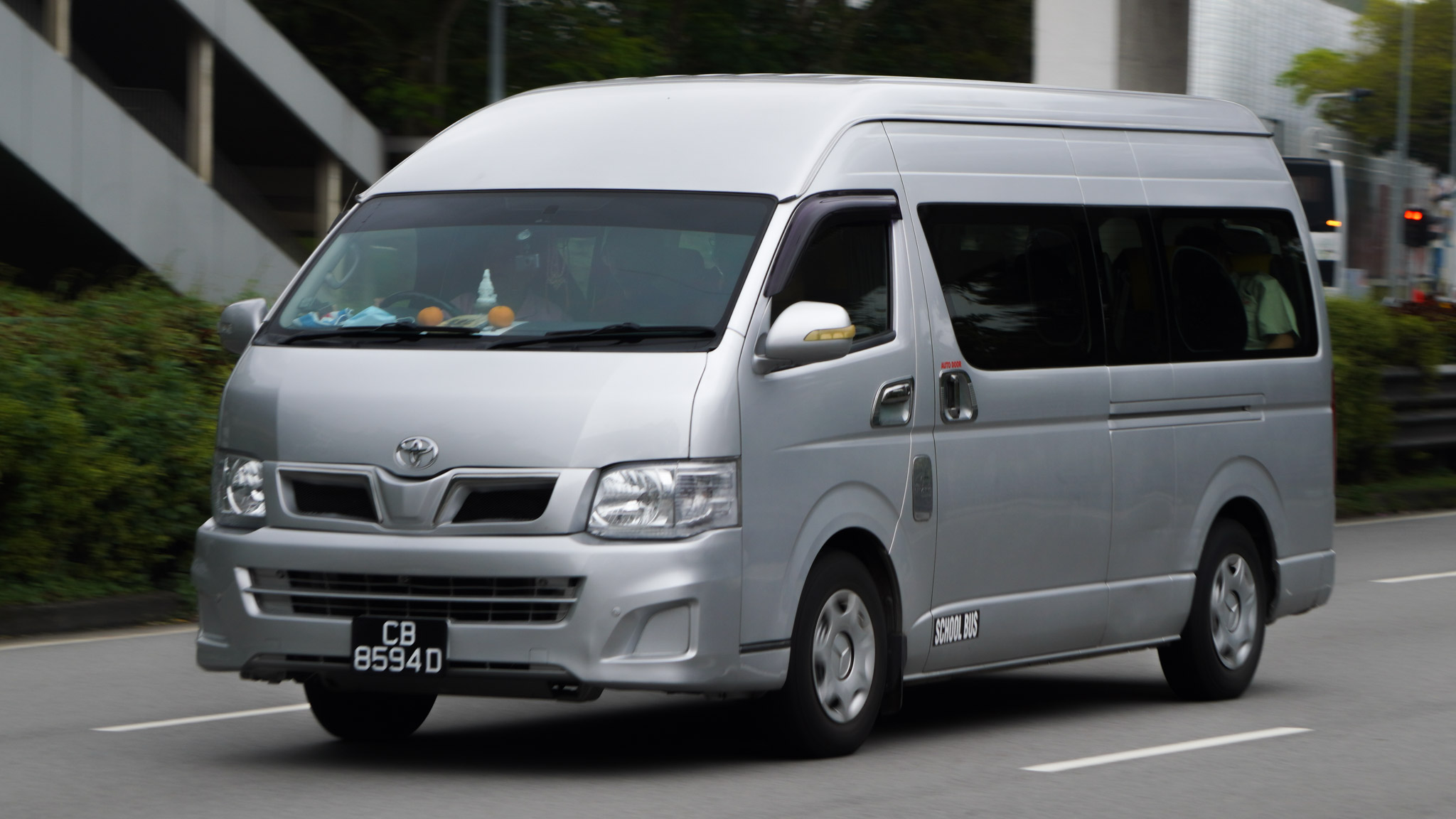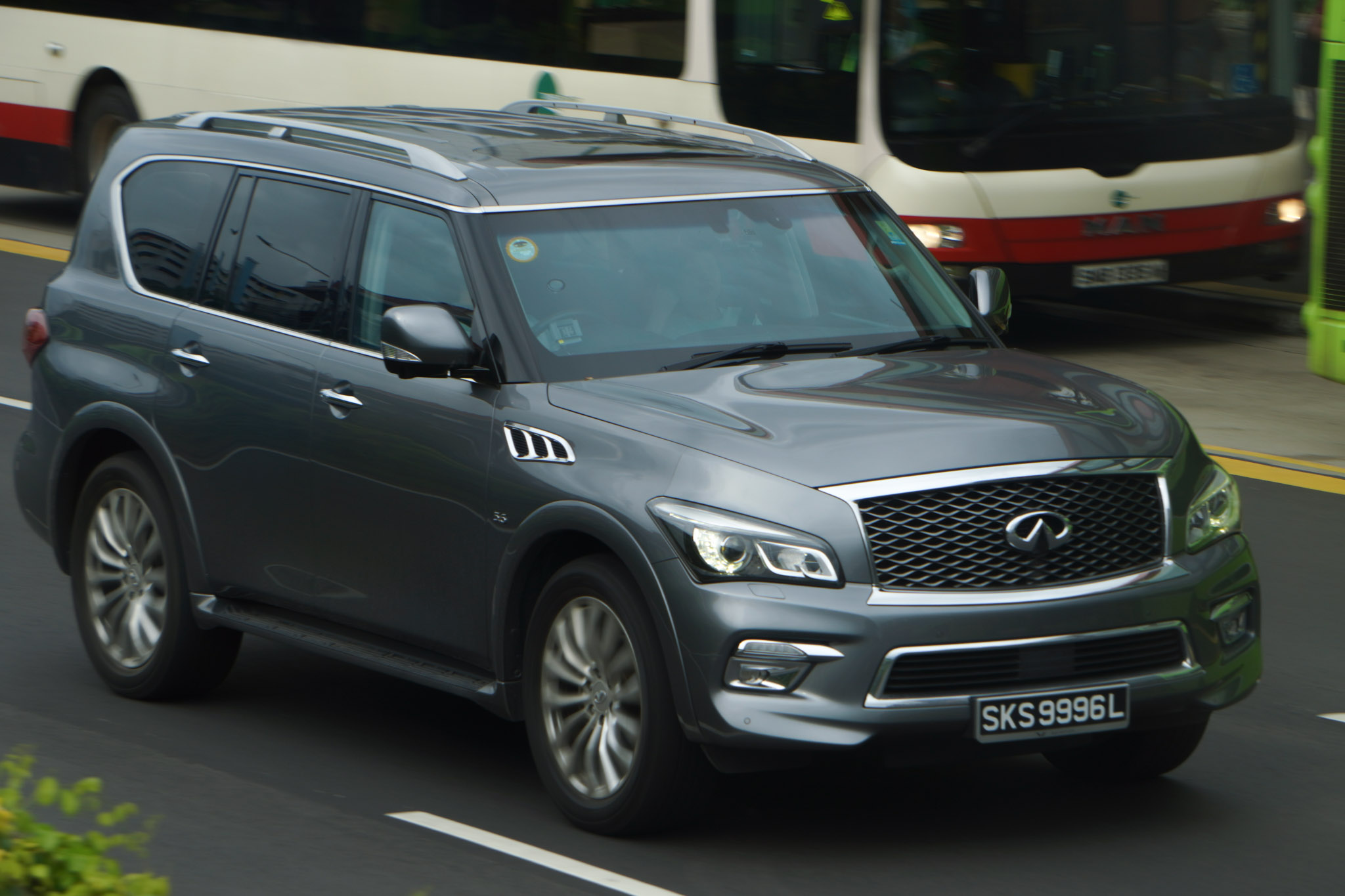The Motorist Guide to the COE system
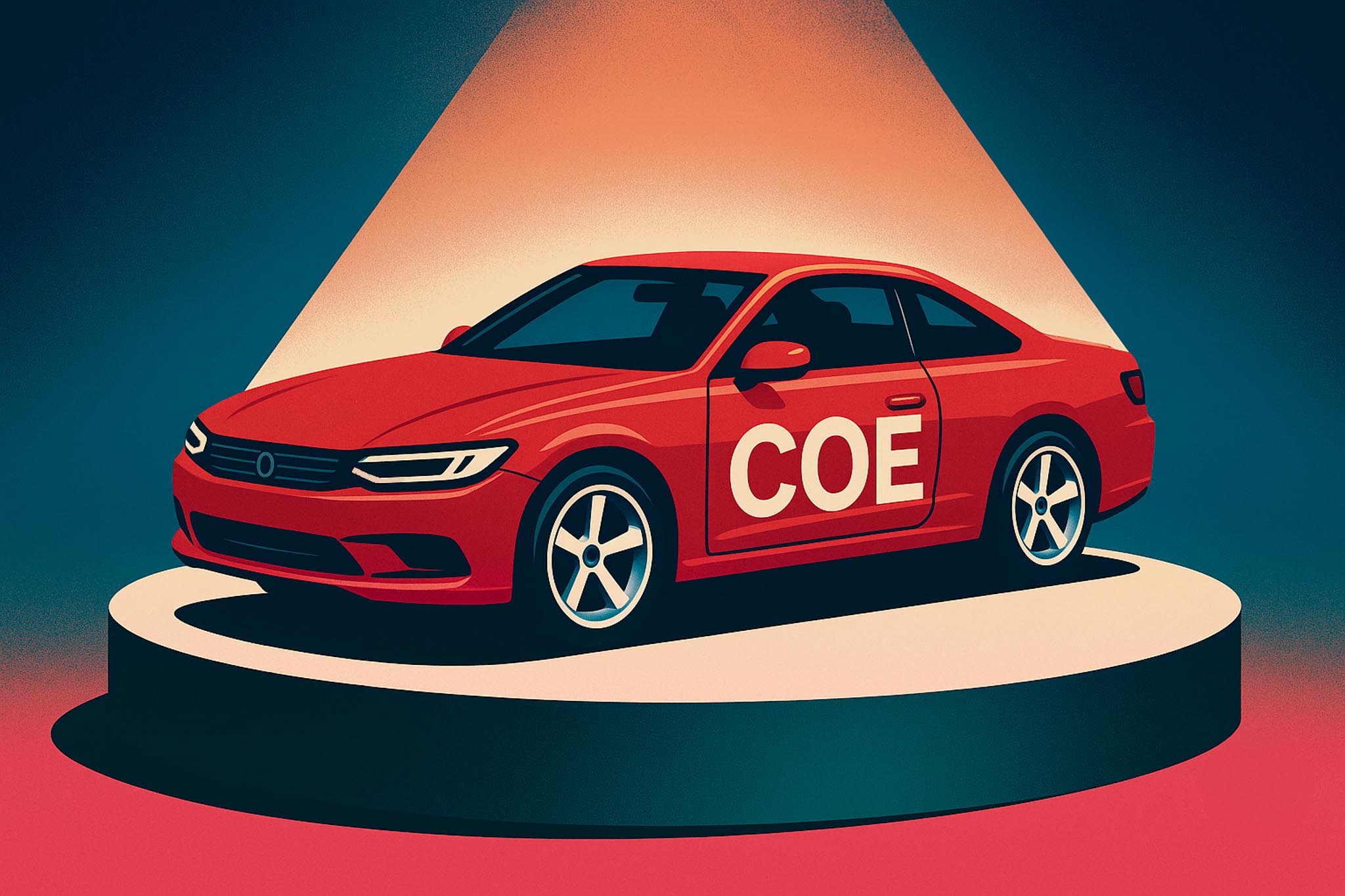
Here's what you need to know about the certificate of entitlement (COE) - what it is, how COE bidding works, and the financing options available for car buyers.
If you plan to buy a car (or any other vehicle) in Singapore, you’ll need to understand how the COE works. Introduced in 1990 to control Singapore's vehicle population, the COE system helps manage road congestion by limiting how many new vehicles can be registered per month.
In practice, every private vehicle registered in Singapore must have a valid COE, otherwise it cannot be used on Singapore roads.
Below, we’ll break down what a COE is, the different categories, how the bidding process works, and how you can finance this hefty expense.
What is a COE (certificate of entitlement)?
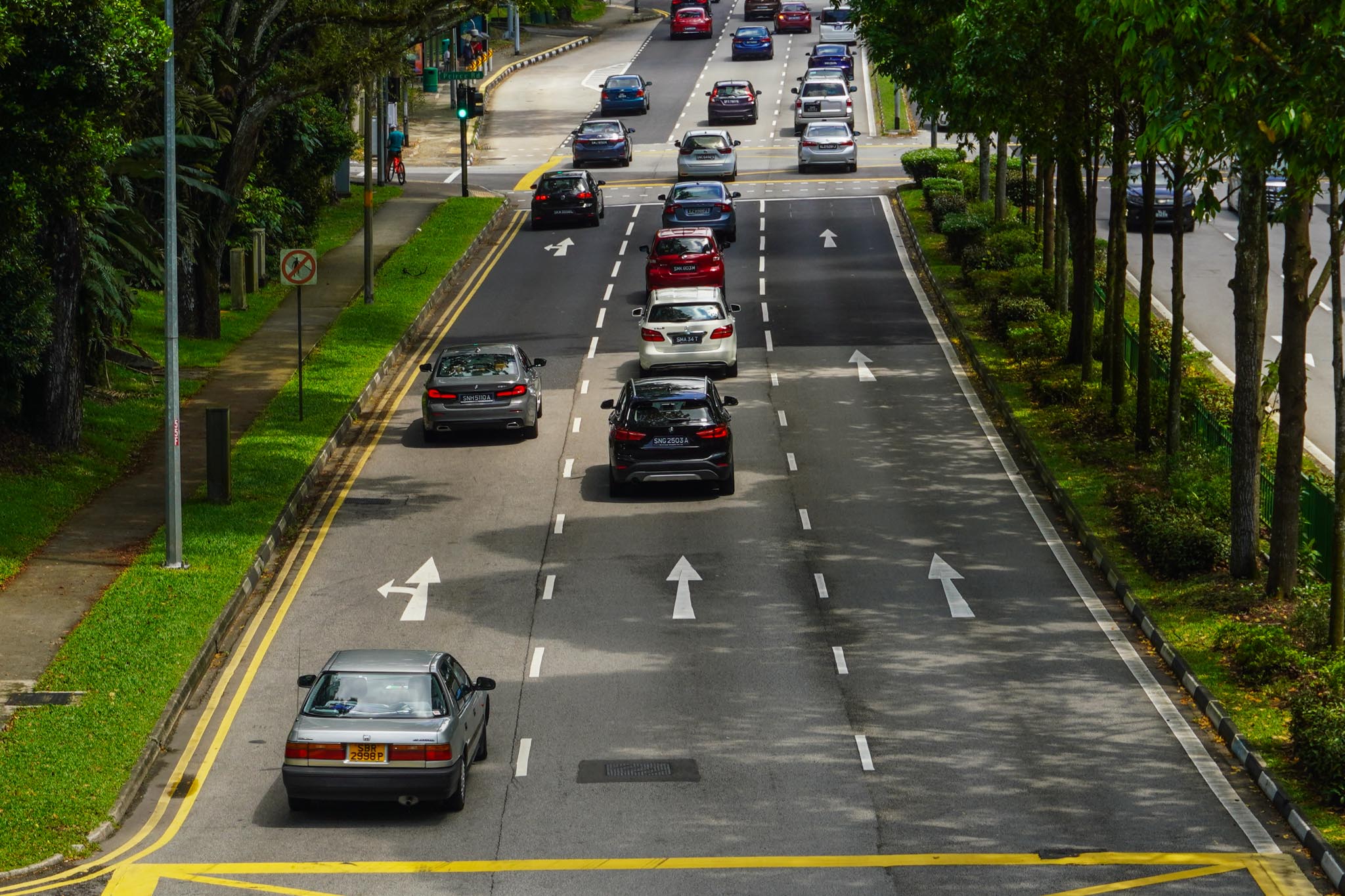
A certificate of entitlement (COE) is essentially a government permit that gives you the right to own and use a vehicle in Singapore. Without a COE, you cannot register a car, motorcycle, or any motor vehicle on public roads.
The COE system was introduced in 1990 as part of the vehicle quota system (VQS) to cap the number of vehicles on the road and curb traffic growth. It is valid for 10 years from the date of registration of a vehicle.
After 10 years, the COE on the vehicle expires. At that point, the vehicle owner must either deregister the vehicle (scrap or export) or renew the COE by paying the prevailing quota premium (PQP) for another five or ten years. The PQP is the moving average of the COE prices in the most recent three months for that vehicle category.
Five-year COE renewals cannot be extended further, while 10-year COE renewals can be renewed again at the end of the lifespan extension.
If you deregister a vehicle before its COE is up, you may get a rebate for the unused months of COE. This ensures that each COE (and the vehicle it’s tied to) only lasts a fixed period, thus helping to continually manage the total vehicle population.
A COE can be attained via bidding exercises held twice every month, and may fluctuate. COE prices (also known as quota premiums) have been on an uptrend in recent years, exceeding $100,000 in recent months for certain categories.
COE categories in Singapore
COEs are divided into five categories (A, B, C, D, E), each corresponding to different vehicle types. You bid for a COE in the category that matches the vehicle you want to register. Here’s a breakdown of the COE categories and what they cover:
Category A
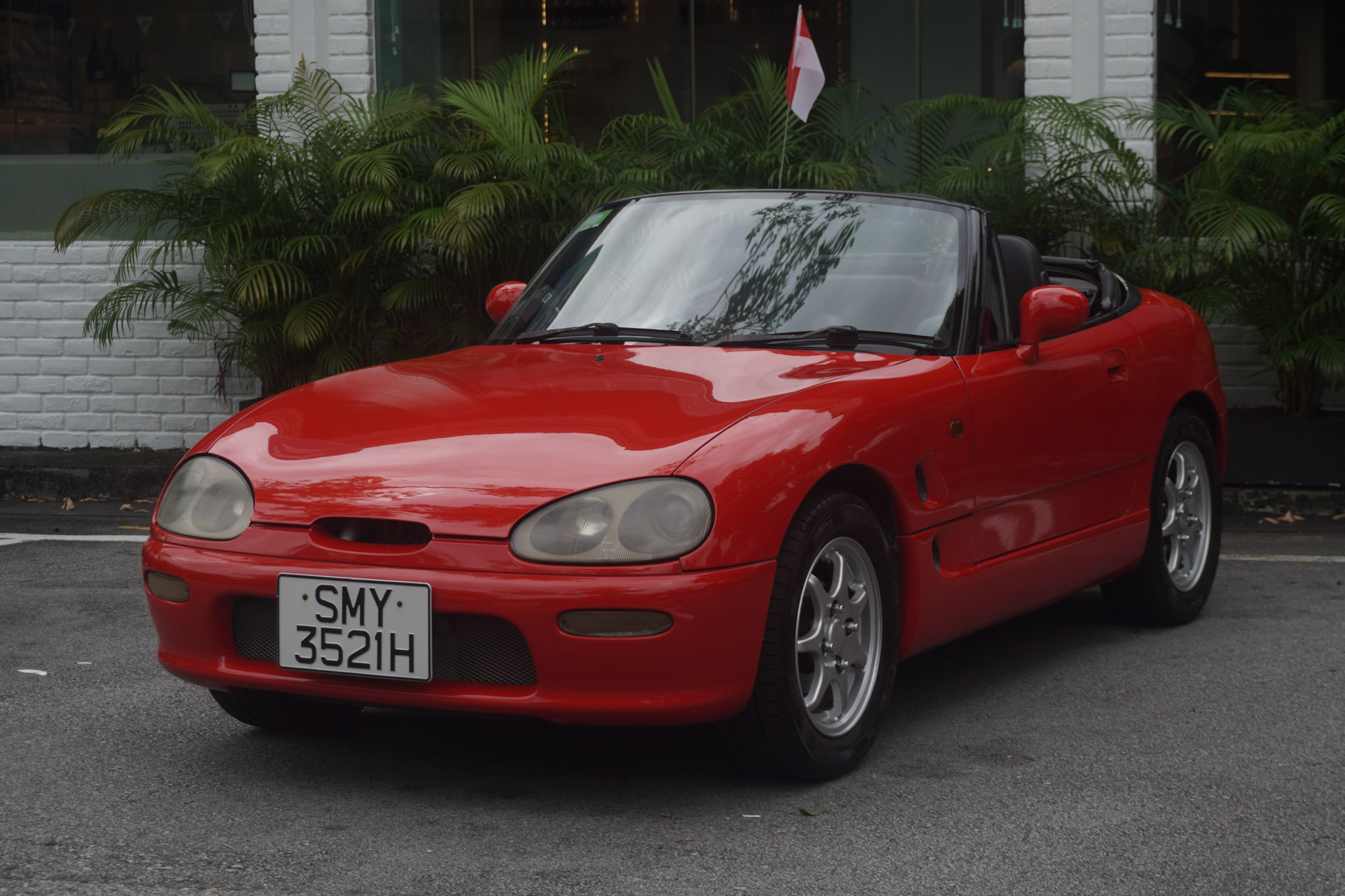
- Cars with internal combustion engines up to 1,600 cc in capacity and with a power output of up to 97kW/130bhp. This group includes petrol-electric hybrids.
- Electric cars with a motor power output of up to 110kW/147bhp.
This COE Category covers most mass-market cars across the different bodystyles - sedans, hatchbacks, SUVs, MPVs, etc.
Category B
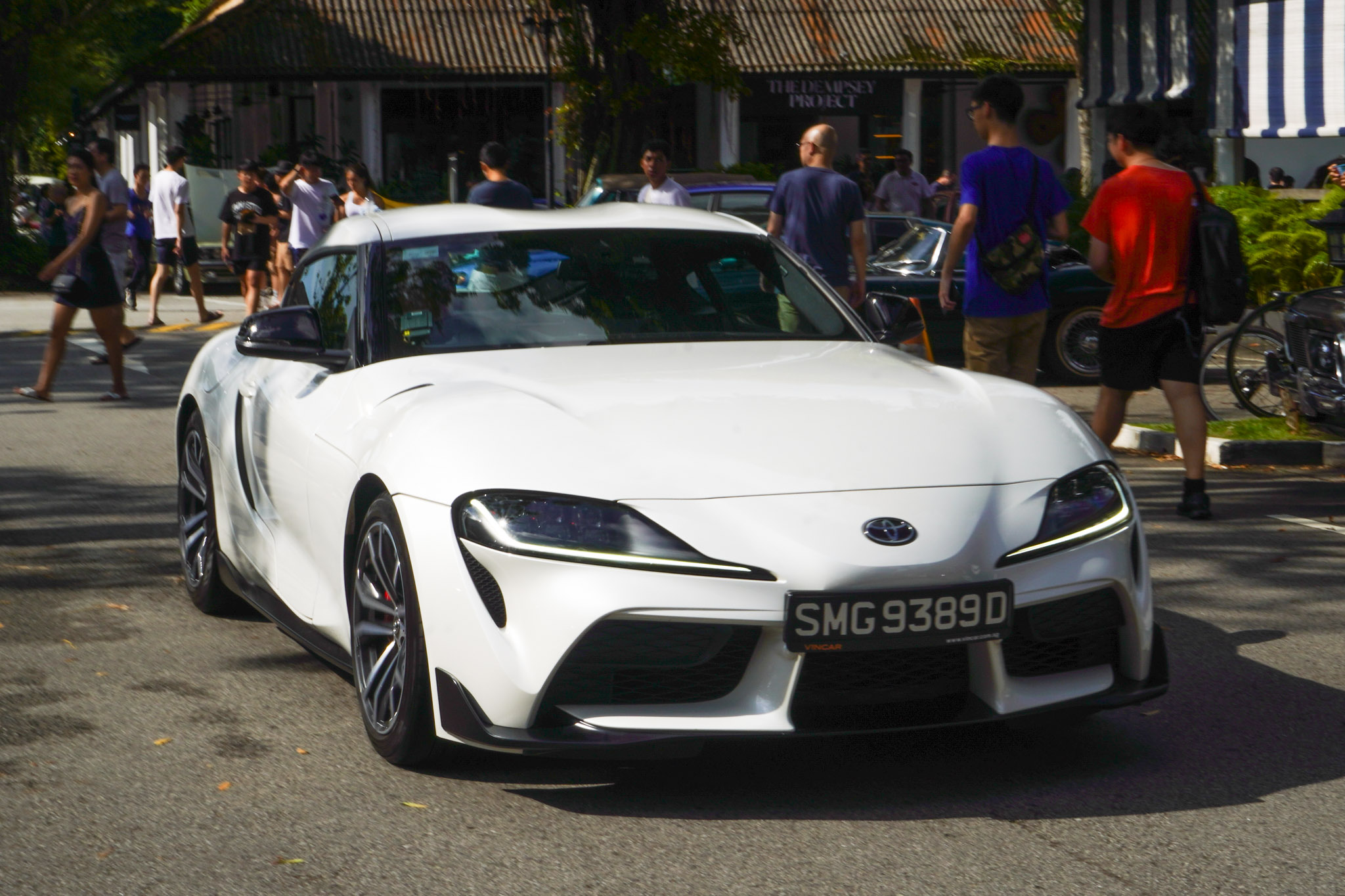
- Cars with internal combustion engines above 1,600 cc in capacity or with a power output of more than 97kW/130bhp. This group includes petrol-electric hybrids.
- Electric cars with a motor power output of more than 110kW/147bhp.
This COE Category covers bigger and costlier cars such as luxury rides, upscale SUVs and performance models.
Category C
- COE Category C in this case stands for "commercial". This COE is for goods vehicles (such as vans and trucks) and buses too (from minibus-size to full-size).
Category D
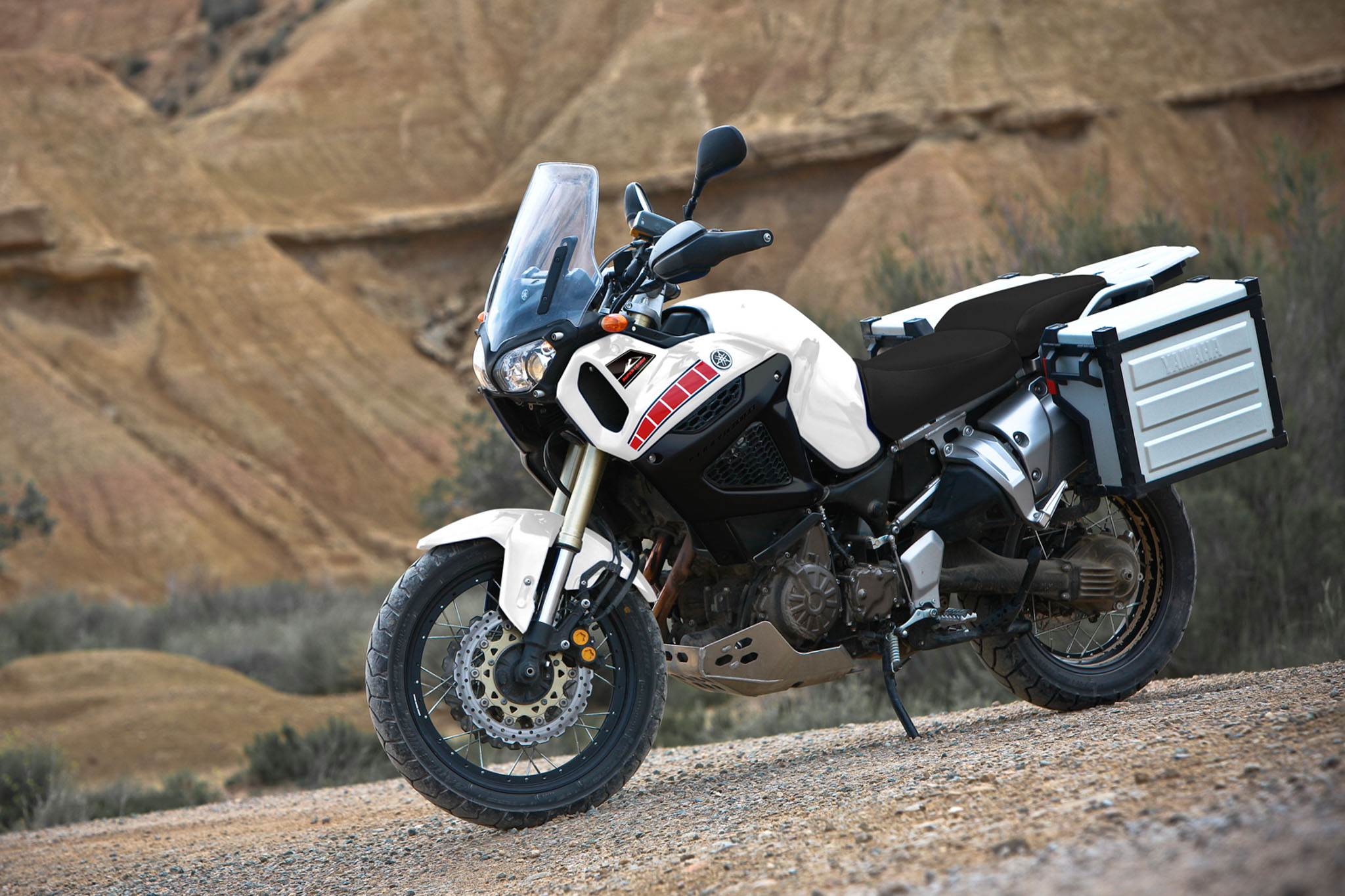
- This COE Category is for motorcycles and scooters too.
Category E
- COE Category E is also know as the Open Category, because it can be used for any vehicle type except motorcycles.
This category is useful for flexibility - a Category E COE can later be used to register a vehicle in Category A, B or C as needed, although Cat E COEs are almost always used for larger and more powerful cars in Cat B. Therefore, both the "big-car" COE Categories E and B tend to be similarly priced.
COE Categories A, B, and D are non-transferable. Once you secure a COE in any of these categories, it’s tied to you and the relevant vehicle type until it’s used.
Categories C and E, however, are transferable once if the COE was obtained by an individual and not a company.,
This means an individual who secures a Cat C or Cat E COE is allowed to sell or transfer it to another person before it’s used to register a vehicle, but only once. However, the same two categories of COE secured by companies are not transferable at all.
How does COE bidding work?
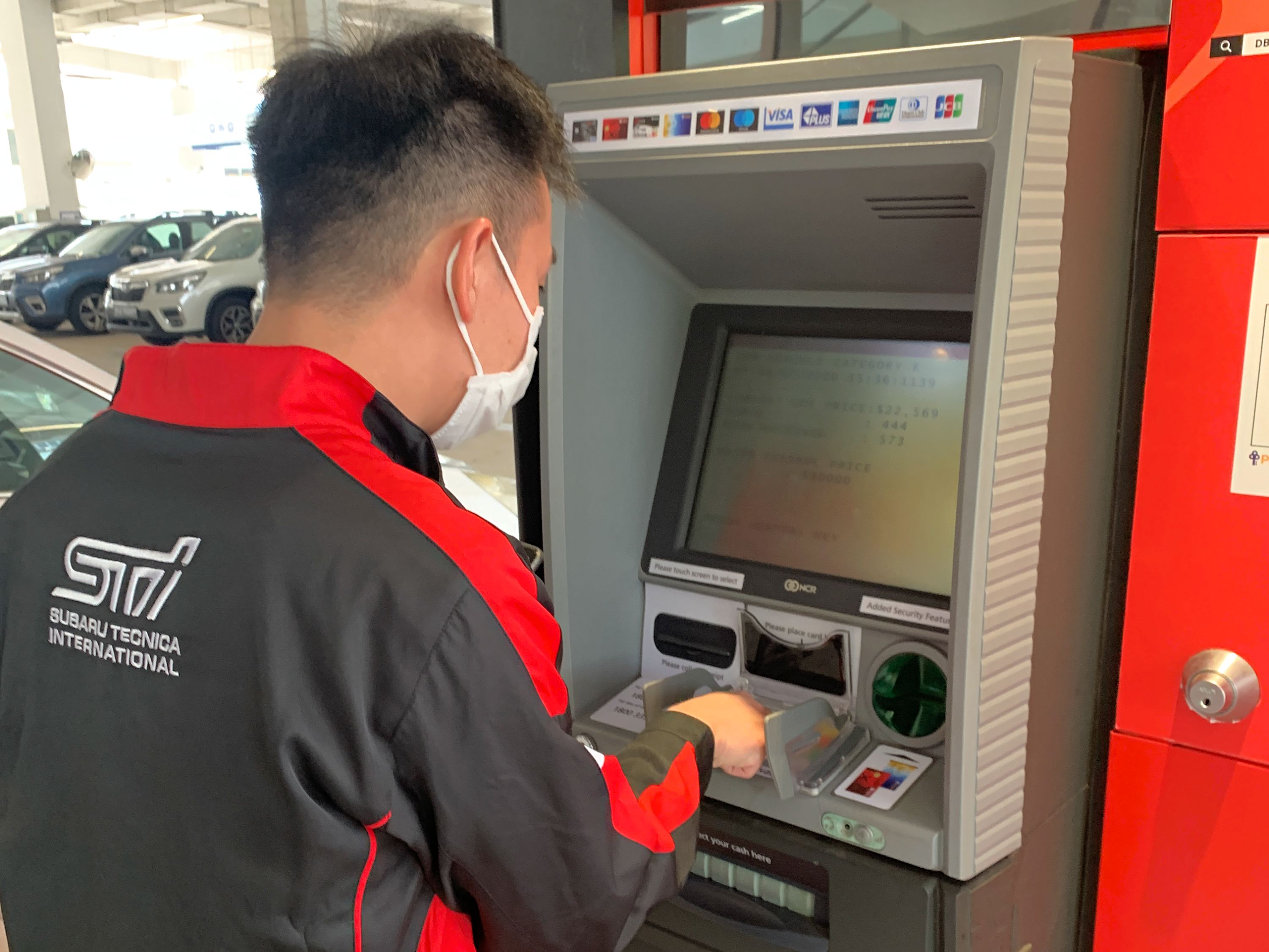
COE bidding is conducted in an open-auction format run by the Land Transport Authority (LTA) on a regular schedule. Here’s how the process works:
Bidding schedule
There are two COE bidding exercises each month. Typically, an exercise starts at 12pm on the first and third Mondays of the month and lasts for three working days, closing at 4pm on Wednesday (assuming there is no public holiday in the week that requires a corresponding change in the schedule).
The usual gap between COE bidding rounds is two weeks, but it becomes a three-week gap in a five-Monday calendar month, depending on the year in question. 2025, for example, has three COE bidding dates (April 9, July 9 and October 8) which are preceded by a three-week interval.
Bidding submission
During the open bidding period, eligible participants submit their bids electronically. Bids are placed through the designated banking channels - DBS/POSB ATMs for individuals, and internet banking via DBS, UOB or Maybanks for companies or motor dealers.
You must have a bank account with one of these approved banks to bid, and each person (or company) can submit bids according to the rules. For instance, individuals are allowed one bid per exercise in their own name, whereas companies can submit multiple bids.
In practice, if you’re buying a new car from a dealership, the dealer/salesperson will usually handle the COE bidding for you as part of the purchase process. Dealers usually bundle their cars with COE inclusive.
This could be a “non-guaranteed COE” package whereby the dealer agrees/attempts to secure a COE within a certain price range and time period (e.g. three months and up to six bids), or a “guaranteed COE” package (which is priced higher) whereby they promise to obtain the necessary COE within an agreed/contracted timespan and deliver the car thereafter.
Bid reserve price
When submitting a bid, you don’t pay the full amount upfront. Instead, you enter a reserve price (also called your maximum bid). This is the highest price you are willing to pay for the COE.
You also put down a bid deposit, which is a fixed amount depending on the category. For the car categories (A, B, C, and E), the deposit is S$10,000 per bid, and for motorcycles (Category D), the deposit is S$1,500 as of 2023.
The deposit is deducted from your bank account when you place the bid, along with a small non-refundable admin fee (about $2 to $10) charged by the bank. The reserve price you set is confidential – other bidders cannot see how much you’re willing to pay.
Bidding process
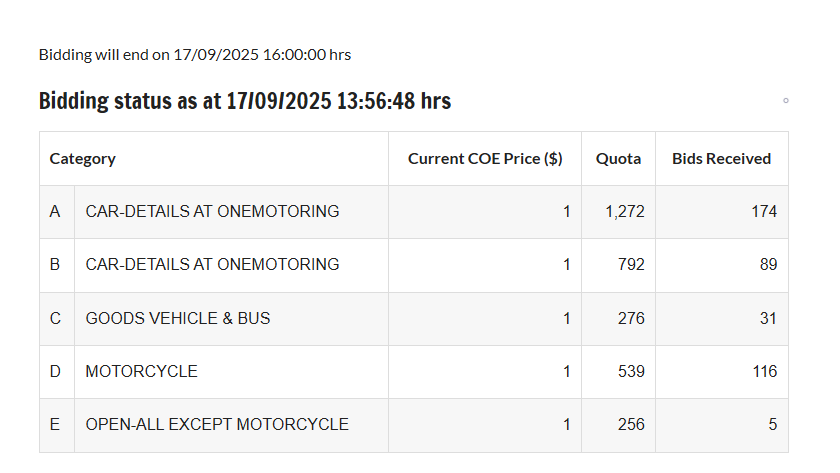
Once bidding opens, all incoming bids are logged and the current COE price (CCP) is continually updated. The COE system essentially works like an automatic auction - it will raise the price gradually in $1 increments, from $1 upward, as long as there are more bids than available COE quota.
Each bidder’s offer will automatically remain in play up to their reserve price. At any point during the three-day exercise, you can check the provisional current price and see how many bids have been received versus the quota.
If the current price exceeds your reserve price, your bid becomes “outbid” – essentially, you’re no longer in the running because others are willing to pay more than you. However, you have the option to revise your bid upwards (increase your reserve price) while the exercise is still open, if you decide you’re willing to pay more.
You cannot reduce or withdraw your bid - you can only raise it. This dynamic continues until the closing time. Historically, most of the bidding activity happens in the last 30 minutes before the COE exercise ends.
Determining the winning price
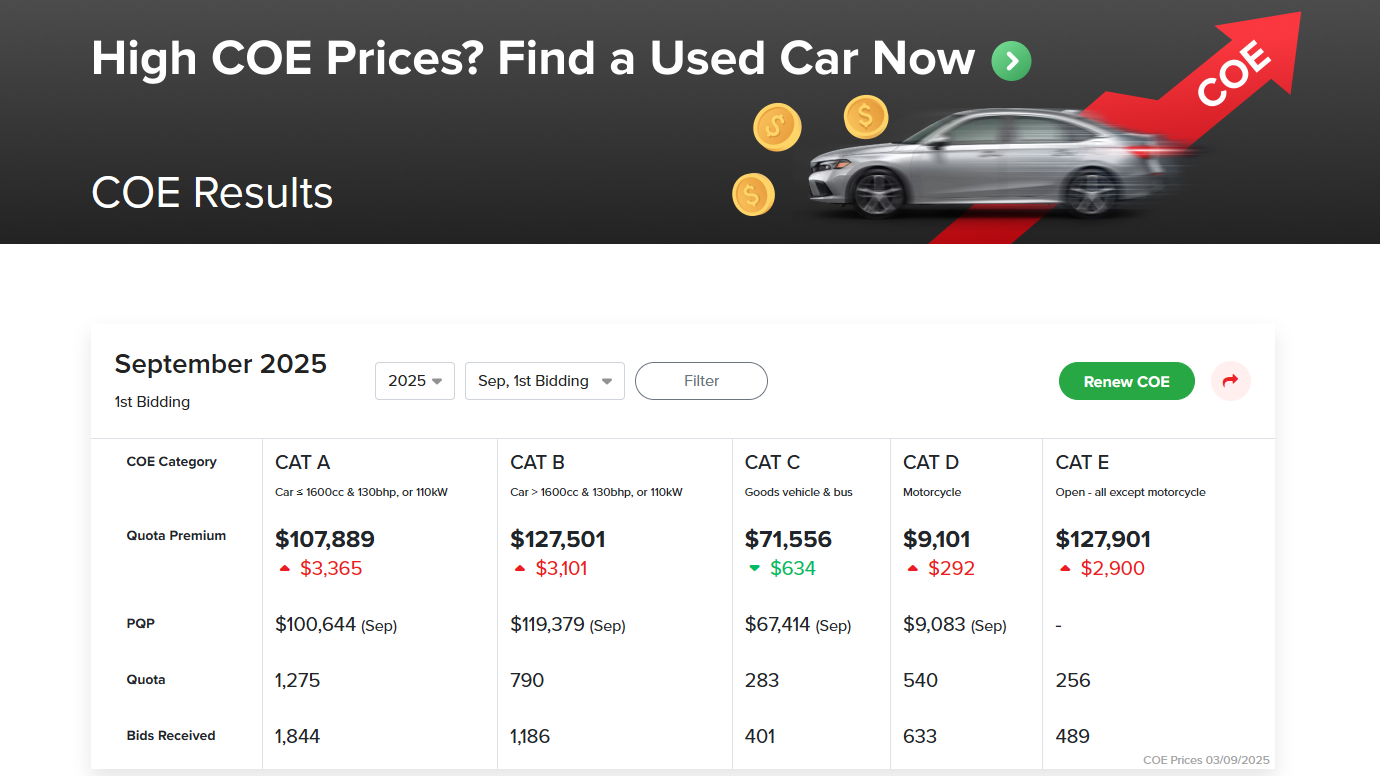
When the COE bidding concludes, the system will determine the strike price. The current COE price at closing becomes the quota premium for that category.
In simple terms, the quota premium is the lowest successful bid price. How is this determined? The system stops accepting new bids once the number of bids at or above a certain price equals the quota available. For example, if there are 100 COEs available in Category A, the highest 100 bids will secure a COE. The price of the 101st highest bid (the highest failed bid) plus $1 is the cut-off price.
All bidders who set a reserve price at or above that cut-off point will get a COE, and they all pay the same final price (the quota premium).
This means even if you were willing to pay much more, you’ll only pay the quota premium price, not your full reserve. Conversely, anyone who bid below that price gets nothing.
To illustrate, if the quota ends up filled by bidders willing to pay $80,000 and up, and the next best offer was $79,999, the quota premium will be $80,000 (since $79,999 + $1 = $80,000). Everyone who bid $80,000 or more secures a COE at $80,000. This pay-as-clear auction format, unlike the other method of pay-as-bid, ensures that all winners pay an equal price.
Bidding aftermath
The results are announced publicly once the exercise closes, which is usually on Wednesday at 4pm. If your bid was successful, you’ll be issued a temporary COE (TCOE) in your name, which is valid for a few months – you then use it to register your new vehicle within that validity period.
Your bid deposit will go toward paying the COE premium. If the premium is higher than your deposit (which is always the case unless there's a fluke result), you’ll need to top up the difference when registering the vehicle. In the unlikely event that the premium is lower than your bid deposit, the excess deposit is refunded to you.
If your bid was unsuccessful, your full $10,000 (or $1,500 if it's for Category D) deposit is refunded (after deducting the small admin fee), usually by the next working day. You won’t lose the deposit unless you win a COE and then fail to use it to register a vehicle before the TCOE expires - in which case, the COE is forfeited and your deposit is forfeited as well.
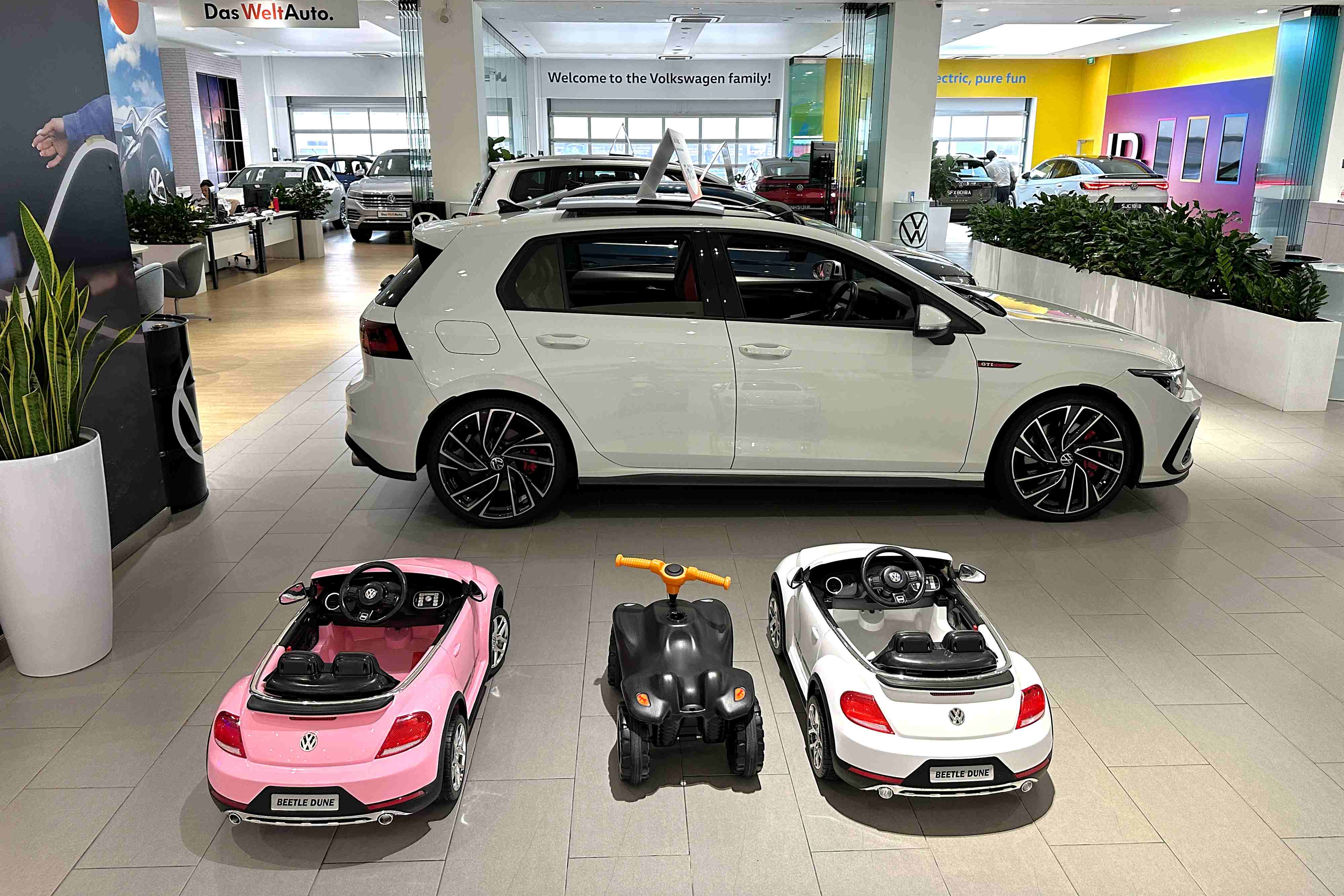 COEs are required for all the cars in this showroom, except the two little Beetle cabrios.
COEs are required for all the cars in this showroom, except the two little Beetle cabrios.
Can I use a loan to pay for the COE?
The COE premium is part of the total cost of a vehicle, and buyers commonly finance their car purchase with a car loan from a bank. Singapore’s regulations allow a maximum car loan of up to 60 or 70 precent of the vehicle’s price (including COE), depending on the open market value (OMV) of the car.
This means the bank loan can cover a significant portion of the COE cost since it’s bundled in the car price. However, the remaining 30 to 40 precent of the price needs to be paid in cash or with other financing. If the COE price is extremely high, finding the cash for the downpayment can be challenging.
For those who need help funding the COE or prefer not to pay such a large sum upfront, one option is taking a personal loan.
Banks or financial institutions offer unsecured personal loans that some buyers use to cover the COE or downpayment. According to financial advisors, personal loans can potentially finance around 60% to 70% of a vehicle’s cost.
If you are renewing an existing car’s COE (for example, your car is almost 10 years old and you decide to extend its life by renewing the COE for another five or ten years), you need to pay the prevailing quota premium (PQP) to renew.
Many banks offer specific COE renewal loans designed for this scenario. These are loans that can cover up to 100% of the PQP (COE renewal cost), essentially allowing you to refinance the full cost of renewing the COE.
COE renewal loans usually have tenures of up to seven years (for 10-year renewed COE) and are structured similarly to car loans, but without a vehicle as collateral, so interest might be slightly higher than a standard car loan. Renewing a vehicle's COE with a loan also entails a vehicle transfer as part of the proper process.
Read More: The Motorist Guide to car insurance – comprehensive versus third party
Super App for
Vehicle Owners
Download the Motorist App now. Designed by drivers for drivers, this all-in-one app lets you receive the latest traffic updates, gives you access to live traffic cameras, and helps you manage LTA and vehicle matters.
Did you know we have a Motorist Telegram Channel? Created exclusively for drivers and car owners in Singapore, you can get instant info about our latest promotions, articles, tips & hacks, or simply chat with the Motorist Team and fellow drivers.
